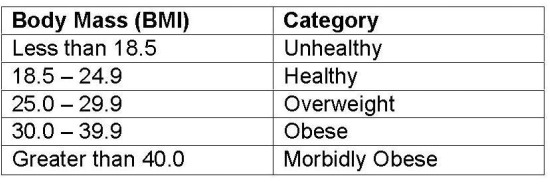Body Mass Index
First established in 1830 by the Belgian mathematician Adlophe Quetelet, Body Mass Index (BMI) has been in more common use today as a general indicator of obesity since it was promoted by American scientist Ancel Keys in 1972, in his article appearing in the Journal of Chronic Diseases.
BMI takes into account a person’s weight and height to gauge total body fat in adults, and is used as a measure to determine when extra pounds translate into health risks. Calculate your BMI to see if your weight is in the healthy range for your height, as follows:
- Multiply your current weight (in lbs.) by 703;
- Divide that answer by your height (measured in inches);
- Divide that answer again by your height (measured in inches);
- Compare your BMI to the chart below:

By itself, your Body Mass Index does not predict your health risk, but most doctors would consider a BMI over 30 to be unhealthy. However, some studies on aging suggest that a bit higher BMI, say around 27, could be better by the time we reach 75 (a bit extra fat may provide extra energy to our immune system to fight off infections such as flu).
Body Mass Index - Additional Considerations
While there is a reasonable relationship between BMI and body fat, there are some variations due to age, gender and other circumstances, and hence should not be considered as an absolute indicator of good health or obesity. For example, even at the same BMI levels, older adults tend to have more body fat than younger adults, just as women tend to have more body fat than men. In addition, well-conditioned athletes may well have a greater BMI due to greater muscle mass, and hence fall into an at risk categorization but in reality such individuals are generally quite healthy and fit.
Needless to say, the benefits to maintaining a healthy weight go well beyond having clothes that fit. It's a greater quality of life that includes:
Finally, it's important to note that BMI is only one of the factors used to predict risk of disease and obesity. The National Heart, Lung and Blood Institute identifies abdominal fat, high blood pressure and physical inactivity as additional predictors for obesity related diseases.
- Home ›
- Healthy Life ›
- Body Mass Index
